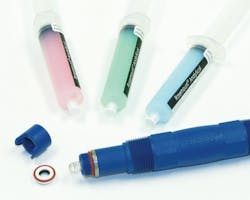Thermoplastic, Magnetically Driven Pumps Stand Up to Corrosion
With the increasing need to control odor and neutralize pH in water treatment systems comes a growing requirement to pump sodium hydroxide, sodium hypochloride, alum, sulfuric acid, ferric chloride, polymer and other corrosive solutions. Spanning extremes at both ends of the pH range, these chemicals commonly attack pumps constructed of stainless steel and more noble alloys, all of which have annual corrosion rates, as well as metal pumps lined with plastic.
According to Vanton Pump, which will be exhibiting its products at WEFTEC 2010, all such corrosion-related pump problems can be eliminated by completely isolating the fluids being pumped from metal or fiberglass, regardless of whether wear or abrasion has occurred throughout the life of the pump. The company accomplishes this in two ways:
First, it injection molds all wet end components of thermoplastics that are abrasion resistant, and 100% inert relative to the specific fluid being handled. These solid, homogeneous materials include PVC (polyvinyl chloride), PP (polypropylene) and PVDF (polyvinylidene fluoride). Because the parts are molded, versus machined, they are thick-sectioned, stand-alone, replaceable components, and have smooth, tight-tolerance surfaces. They are also unaffected by wear and are not subject to delamination or porosity, unlike plastic coated parts.
The thermoplastic wet-end is encased by structural metal armor that is protected by a chemical resistant epoxy coating, enabling the pump to withstand hostile environments and tolerate the same nozzle loadings as metal pumps.
Secondly, the company eliminates the possibility of leakage through motor shaft seals by eliminating the seals themselves – with a magnetic drive option that transmits power using high performance permanent rare earth magnets, with the inner magnet rotor assembly encapsulated in PP or PVDF. The design uses a nonmetallic containment can assembly consisting of a fluoropolymer for the inner can in direct fluid contact, backed by a rigid plastic outer can. This avoids troublesome eddy currents that reduce pump efficiency by loss of magnetic force.
Case Study
The performance of the aforementioned, magnetically driven thermoplastic pumps is demonstrated by a typical installation at a major WTP, in which two sealless, magnetically driven thermoplastic pumps move sodium hydroxide from 12,500 gallon double wall storage tanks to a 500 gallon double wall day tank on demand.
In 1997 the plant switched from a manual system using granular hydrated lime to an automated, instrumented system based on neutralizing with 25% sodium hydroxide, to maintain an alkaline pH in 24 mgd of wastewater.
The pumps are 3 x 2 in. polypropylene flanged designs with 6 in. keyed impellers that handle 55 gpm at 30 ft TDH. They have dual nonmetallic containment can assemblies, and high performance permanent rare earth magnets driven by 3 hp, 460/3/60, 1800 rpm, chemical duty motors.
The casing, casing cover and impeller are molded of homogeneous polypropylene, and the stainless pump shaft is isolated from the fluid by a thick-sectioned thermoplastic sleeve.
The pumps are tied into programmable controls that have eliminated manual labor, reduced operating and reporting time, provided more accurate and timely operational information and records, and materially improved the workplace environment.
After approximately 13 years of 24/7 operation, the magnetic drives and thermoplastic wet ends of these pumps have performed without failure.
Success of the overall installation prompted the facility to increase capacity of the system from 24 to 36 mgd. WW
Vanton is an exhibitor at the WEFTEC.10 event and can be found at Booth No. 3051More WaterWorld Current Issue Articles
More WaterWorld Archives Issue Articles


